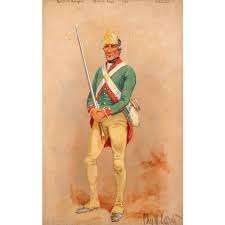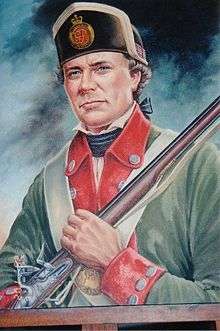Butler's Rangers
| Butler's Rangers | |
|---|---|
 A soldier in Butler's Rangers during the American Revolutionary War, wearing a green wool coat, buff trousers, and a brass regimental plate on a round wool hat, from a 1910 painting by American artist Charles M. Lefferts. | |
| Active | 1777-1784 |
| Country |
|
| Allegiance |
|
| Branch | British provincial unit |
| Type | Rangers, (auxiliary troops) |
| Role | Special operations, maneuver warfare, guerrilla warfare, light infantry |
| Size | Twelve companies, regiment (800) |
| Engagements |
|
| Commanders | |
| Notable commanders |
General Sir William Howe
|

Butler's Rangers (1777–1784) was a Loyalist, British provincial military unit of the American Revolutionary War, raised by Loyalist John Butler. Most members of the regiment were Loyalists from upstate New York. Among the Rangers was also a body of African American former slaves, the total number of their presence in Butler's Rangers is unknown, with estimates ranging from two to "more than a dozen". While some served in other Loyalist units and as sappers in the Engineer Corps and Royal Artillery, Sir William Howe prohibited their enlistment in the British Army, and ordered the disbandment of existing black regiments.[1] The Rangers were accused of participating in — or at least failing to prevent — the Wyoming Valley massacre of July 1778 and the Cherry Valley massacre of November 1778 of European settlers (including some Loyalists) by Iroquois forces under the command of Joseph Brant. These actions earned the Rangers a reputation for ruthlessness no holds barred warfare tactics. They fought principally in Western New York and Pennsylvania, but ranged as far west as Ohio and Michigan and as far south as Virginia. Their winter quarters were constructed on the west bank of the Niagara River, in what is now Niagara-on-the-Lake, Ontario. Although the building that houses The Lincoln and Welland Regiment Museum, in that community was traditionally known as "Butler's Barracks", it is not the original barracks and never housed Butler's Rangers. It was built in the years following the War of 1812 to house the Indian Department, and received the name because Butler had been a Deputy Superintendent in that department.[2]
Regiment formed
Similar to other Loyalist regiments that fought for the British Crown during the American Revolution, for example the King's Royal Regiment of New York, or Jessup's Loyal Rangers, Butler's Rangers were made up of American Loyalist refugees who had fled to Canada, following the outbreak of the American Revolution. John Butler was a French and Indian War veteran-turned landowner with a 26,000 acre estate near Caughnawaga in the Mohawk Valley. However, on the outbreak of American Revolutionary War, Butler abandoned these landholdings and fled to Canada in the company of other Loyalist leaders, such as the Iroquois chief, Joseph Brant. John Butler served as a deputy to Guy Johnson,[3] himself a loyalist from the Mohawk Valley who led mixed anti-Republican First Nations and loyalist militias.
Campaigns
During the Saratoga Campaign Lieutenant Colonel Butler distinguished himself at the Battle of Oriskany on August 6, 1777.[4] As a result, he was commissioned a lieutenant colonel and allowed to raise his own British provincial regiment. This military group would come to be known as Butler's Rangers.
Organization
The regimental company commanders of Butler's Rangers, 1777–1784, were:
- Captain Andrew Bradt
- Captain Walter Butler (John Butler's son, killed in action, 1781)
- Captain William Caldwell, victor at the Battle of Sandusky and the Battle of Blue Licks
- Captain George Dame
- Captain Bernard Frey
- Captain Lewis Geneway
- Captain Peter Hare
- Captain John McDonell
- Captain John McKinnon
- Captain Benjamin Pawling
- Captain Peter Ten Broeck
- Captain Andrew Thompson
Uniforms
There is an historical debate as to what the Butler's Ranger uniform actually looked like. Variation A Their uniforms consisted of a green woolen coat faced white and a white woolen waistcoat. Their pant garment was gaitered trousers made from Russia sheeting, a hemp product. Their hats were round hats, useful in shielding their faces from the sun. When in garrison or on parade, they could bring up the leaves of that hat to form a cocked hat. Their belting was black.[5] Variation B Dark green coats faced with scarlet and lined with the same, a waistcoat of green cloth, and Buckskin Indian leggings reaching from the ankle to the waist...their caps were almost skull caps of black jacket leather or turned up felt with a black cockade on the left side. Their belts were of buff leather and crossed at the breast where they were held in place by a brass plate marked in the same manner and with the same words as the cap plate. This version is based on supposition rather than primary source materials.
Weapons
They primarily used both the Long-Land and Short-Land forms of the Brown Bess musket. A mix of other firearms may have been used but would have created a supply issue due to calibre variations.[6]
Regiment disbanded and resettled in British Canada
Butler's Rangers were disbanded in June 1784, and its veterans were given land grants in the Nassau District, now the Niagara region of Ontario, as a reward for their services to the British Crown. In 1788 the Nassau Militia was formed with John Butler as its Commander, filling its ranks with the demobilized officers and men of Butler's Rangers. In 1792 the Nassau District was changed to the county of Lincoln and the name of the militia changed to Lincoln Militia by 1793. It was the Lincoln Militia who fought in the War of 1812 (1812–1815). This regiment exists today, following a splitting of Lincoln county into the counties of Lincoln and Welland in 1845, as The Lincoln and Welland Regiment, a primary reserve regiment of the Canadian Forces, based out of St. Catharines, Ontario.
Notable Butler's Rangers
References
- ↑ Paul Rastatter (Summer–Fall 2004). "Black Soldiers and Sailors During the Revolution". The Early America Review. Retrieved 2008-07-13.
- ↑ Lincoln and Welland Regiment Museum: Butler's Barracks. Retrieved on Aug 7, 2016.
- ↑ "Butler's Rangers". CBC News. 2001. Retrieved 2013-09-30.
- ↑ "Oriskany Battle State Historic Site". 2013. Retrieved 2013-09-30.
- ↑ Calvin Arnt (August 10, 2007). "The Butler Ranger Uniform. Fact vs. Opinion" (PDF). Retrieved 2008-07-13.
- ↑ Alan D. Woolley. "Uniforms, Accoutrements and Weapons". Butler's Rangers. Archived from the original on 2008-06-06. Retrieved 2008-07-13.
- Butler's Rangers, The Revolutionary Period by E.A. Cruikshank, published by the Lundy's Lane Historical Society, 1893, fourth reprint edition includes:
- A Nominal Roll of Butler's Rangers compiled by Lieutenant Colonel William A. Smy, OMM, CD, UE
- An account of the most significant actions of Butler's Rangers during the American Revolution can be found in: Williams, Glenn F. Year of the Hangman: George Washington's Campaign Against the Iroquois. Yardley: Westholme Publishing, 2005 and in;
- E. Cruikshank, The Story of Butler's Rangers.
Novels
- Brick, John, The King's Rangers, 1954
- References to this war are described in the novel "Zach" by William Bell
- Miller, Orlo, "Raiders of the Mohawk," 1966. The Story of Butler's Rangers. A romanticized account based on the true life experiences of Daniel Springer, who served in the Rangers along with his older brother, Richard.
External links
- Transcribed by Judy Longley. "Major John Butler's report of July 3, 1778 The Wyoming Massacre". Retrieved 2008-07-13.
- Major Alan D. Woolley CD, The Lincoln and Welland Regiment. "Butler's Rangers website". Archived from the original on 2008-09-19. Retrieved 2008-07-13.
- "Uniforms, Accoutrements and Weapons". Butler's Rangers. Archived from the original on 2008-06-06. Retrieved 2008-07-13.
- Butlers Rangers history, photos, relationship to Six Nations
- The Butler papers Brock University Library Digital Repository
- Butler's Corps of Rangers - Frey's Company, McDonnel's Company, and Bradt's Company, recreated units
- Butlers Rangers, recreated unit